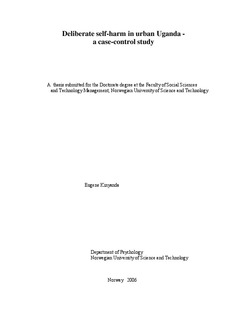| dc.contributor.author | Kinyanda, Eugene | nb_NO |
| dc.date.accessioned | 2014-12-19T14:41:18Z | |
| dc.date.available | 2014-12-19T14:41:18Z | |
| dc.date.created | 2006-01-13 | nb_NO |
| dc.date.issued | 2006 | nb_NO |
| dc.identifier | 126350 | nb_NO |
| dc.identifier.isbn | 82-471-8239-4 | nb_NO |
| dc.identifier.uri | http://hdl.handle.net/11250/270367 | |
| dc.description.abstract | Background: Deliberate self-harm (DSH) is both a personal problem and a public health problem not only in the West but also in sub-Saharan Africa including Uganda. Generally however, there is an absence of suicide interventions on the continent and linked to this problem an absence of recent studies on suicidal behaviour from Africa. To partly address these shortcomings, this present project examined the demographic, social and psychological characteristics of deliberate self-harm in the urban environment of Uganda.
Methods of the study: One hundred cases of deliberate self-harm attending three general hospitals in the Ugandan capital of Kampala were compared with 300 non-DSH in-patient controls from the participating hospitals. Both the cases and controls were interviewed using a Luganda translated version of the modified European Parasuicide Interview Schedule I (EPSIS I; Kerkhof et al. 1989). Two study samples were constituted where sample 1 were the cases and sample 2 the controls. For purposes of DSH repetition part of the study, sample 1 was split into the ‘suicide repeaters’ and the ‘non-repeaters’. Data on; socio-demographics, methods of DSH, precipitating factors of present act of DSH, life events, psychological factors and DSH repetition was collected.
Analysis: The statistical package SPSS 8.0 was used both at data entry and analysis. Analysis involved the generation of frequencies, means and mean rank scores and cross-tabulations using Pearson’s Chi-square test, Fischer’s Exact test and the independent t-test. Multivariate analysis using logistical regression was used to determine the independent effect of various variables in suitably specified models. The level of significance was set at 0.05.
Results: Results revealed that DSH in urban Uganda in a hospital based population was predominantly a problem for male (63%), adolescents and young adults (50%). The predominant method of DSH used was by organophosphate poisoning (45%). The main psychiatric diagnoses associated with DSH in this population were; adjustment disorder (35%), acute stress reaction (18%) and depression (23%).
Disturbed interpersonal relationships (with a partner/lover, parent(s) or children) were a precipitant in 65% of the DSH cases. The number of negative life events in; Childhood (categories of parents, significant others, and personal), Later in life (category of partner), and Last year (category personal and the total number of life events) were significantly associated with DSH in this study. The psychological factors found to be associated with DSH were; global psychological distress, hopelessness and state anger but not depression, trait anger nor alcohol abuse. Suicidal intent was found to be independently correlated with both depression and hopelessness.
Twenty five percent of the DSH cases in this study were repeaters with the socio-demographic factors associated with repetition of DSH including; being single, having children and staying alone or with parents. Other factors found to be associated with DSH repetition were; the number of negative life events in childhood and in the last year, global psychological distress and trait anger but not depression, hopelessness nor state anger.
Conclusion: The picture of DSH in urban Uganda is similar to a great extent to that observed elsewhere on the African continent and in the West. There are however important differences particularly with the picture of DSH as seen in the West. | nb_NO |
| dc.language | eng | nb_NO |
| dc.publisher | Fakultet for samfunnsvitenskap og teknologiledelse | nb_NO |
| dc.relation.ispartofseries | Doktoravhandlinger ved NTNU, 1503-8181; 2006:229 | nb_NO |
| dc.relation.haspart | Kinyanda, E; Hjelmeland, H; Musisi, S. Deliberate self-harm as seen in Kampala, Uganda. Social Psychiatry and Psychiatric Epidemiolog. 39(4): 318-325, 2004. | nb_NO |
| dc.relation.haspart | Kinyanda, E; Hjelmeland, H; Musisi, S. Psychological factors in deliberate self-harm as seen in an urban African population in Uganda . Suicide and Life Threatening Behaviour. 35(4): 468-477, 2005. | nb_NO |
| dc.relation.haspart | Kinyanda, E; Hjelmeland, H; Musisi, S; Kigozi, F; Walugembe, J. Repetition of deliberate self-harm as seen in Uganda. Archives of Suicide Research. 9(4): 333-344, 2005. | nb_NO |
| dc.title | Deliberate self-harm in urban Uganda – a case-control study | nb_NO |
| dc.type | Doctoral thesis | nb_NO |
| dc.contributor.department | Norges teknisk-naturvitenskapelige universitet, Fakultet for samfunnsvitenskap og teknologiledelse, Psykologisk institutt | nb_NO |
| dc.description.degree | PhD i psykologi | nb_NO |
| dc.description.degree | PhD in Psychology | en_GB |
